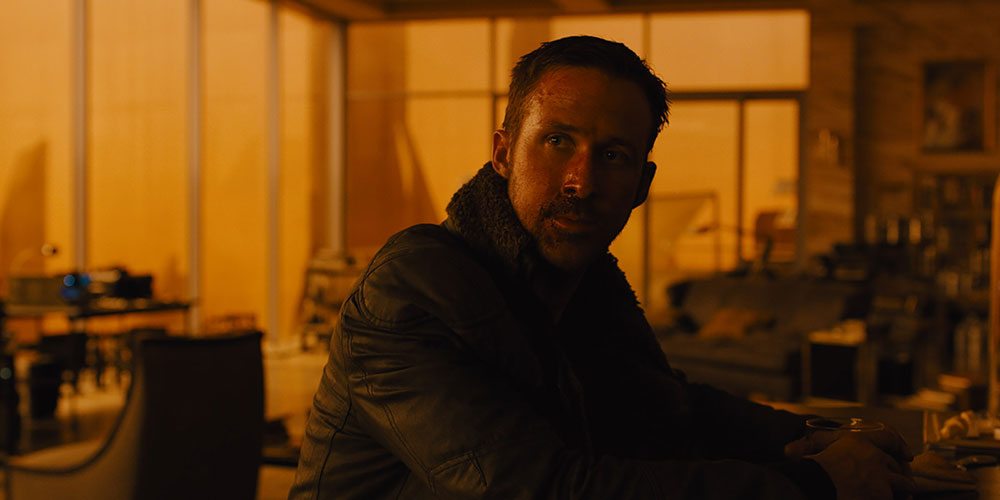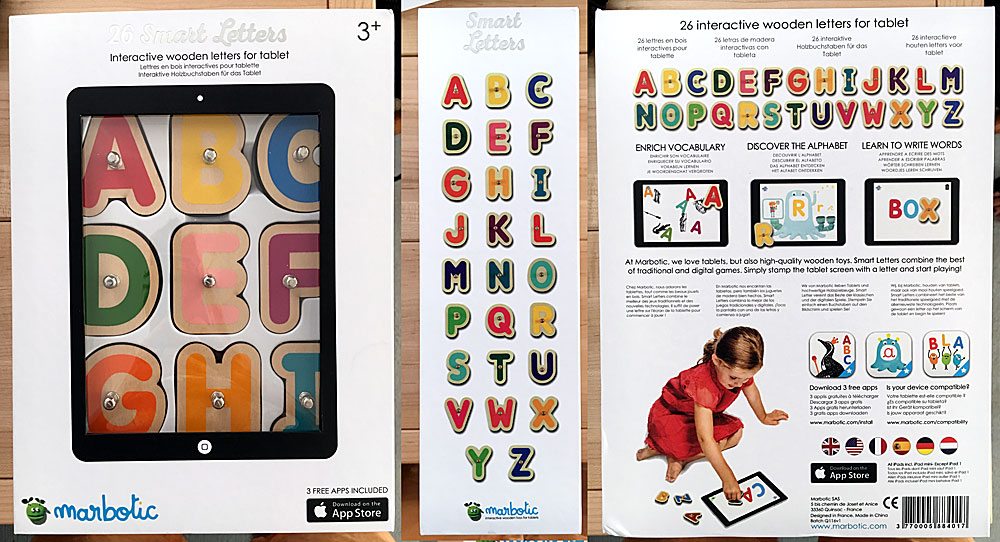Many games with a military theme, whether tabletop games or video games, often take place during World War II. The War to End All Wars, also known as the Great War or World War I is often neglected. Most people think of only trenches and men dying in ‘no man’s land’ from machine gun fire and poison gas. However, the First World War was the first major war after the industrial revolution and most of the weapons used during WWII were first introduced to the battlefields of WWI. Now players can engage in maneuver war with a variety of different types of units and attempt to dominate the WWI battlefield in a legacy campaign in the recently released Trench Club: Legacy.
What Is Trench Club: Legacy?
Trench Club: Legacy is a competitive skirmish game with a legacy campaign for 1-4 players, ages 14 and up, and takes about 60 minutes to play a mission. Players take on the roles of one of the four great powers during World War I and attempt to conquer more forts than their opponents. It’s currently available from the PKB online store, from Amazon, as well as some retailers, and sells for around $119 copy of the game. The second edition of Trench Club is also available for about $100 and consists of the game without the legacy components. Trench Club Legacy was designed by Philipp K. Berger and published by PKB Games.
Trench Club: Legacy Components
Here is what you get in the box:
- 48 faction miniatures
- 20 secret miniatures in 8 legacy boxes
- 14 fort miniatures
- 1 double- sided gameboard
- 1 legacy board
- 5 faction unit mats
- 3 secret envelopes for the legacy game
- 50 news cards
- 100 legacy cards
- 27 dice
- 1 dice chart
- 100+ marker beads
- 20 custom metal coins
- 1 hourglass
- Lots of tokens
- 1 skirmish rule book
- 1 legacy rule book
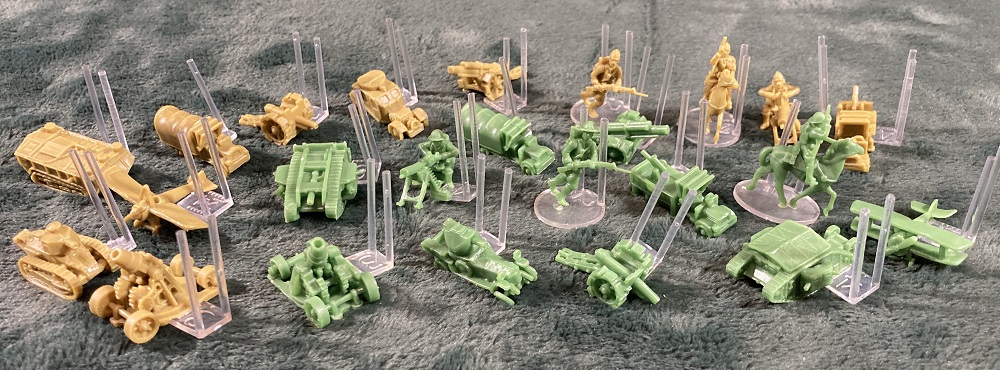
The game comes with a total of 68 miniatures. 12 are available to each of the four factions at the start and the remaining 20 are added during the course of the legacy game. Ten of those secret miniatures are for the United States which did not enter the war until 1917. Each miniature features two small columns off to one side. Colored beads can be placed on these columns to represent damage and experience.
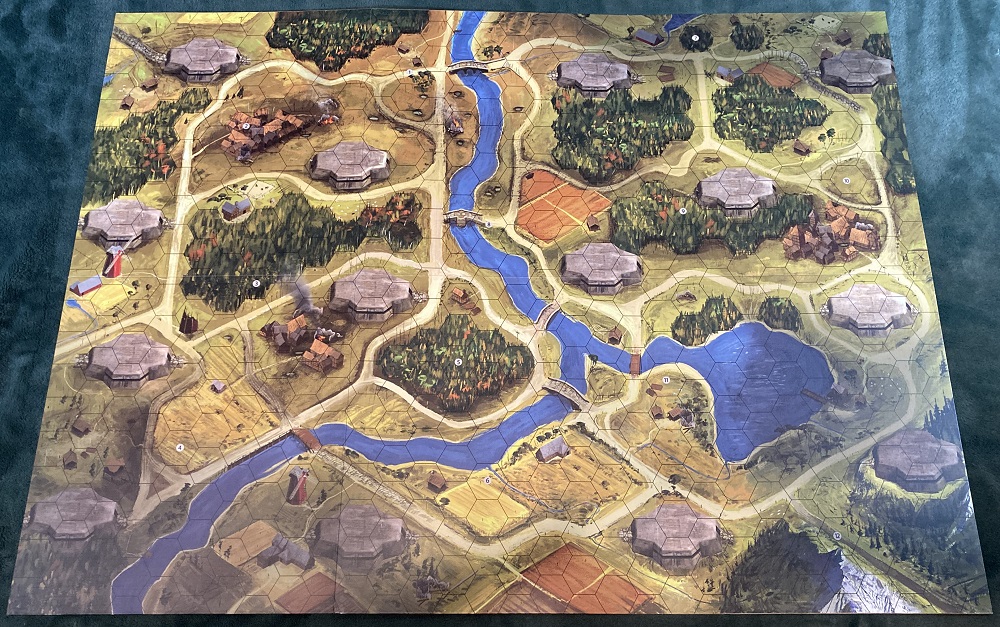
The gameboard features two sides. One is the summer side while the other portrays a snowy winter. The locations of terrain and forts are different on each side. Skirmish players can choose whichever side they want to play while the legacy game tells players which side to use for each battle.
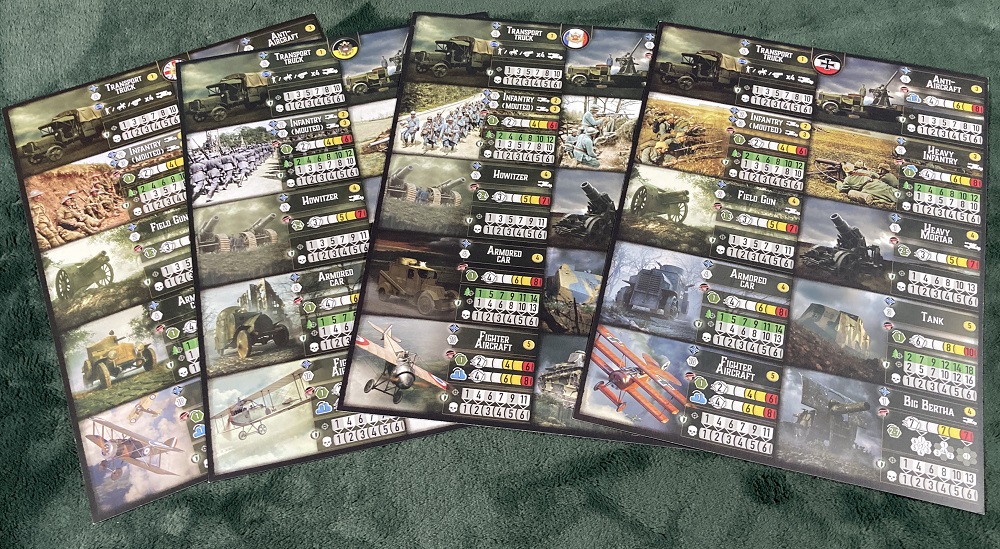
Each faction has their own unit mat. These list all of the information players need to know about their units. To the left of the unit name is the number of speed points that unit has for movement. The cost of the unit in coins and whether it can be transported is shown to the right of the name. Below the name is the range of the units attacks as well as the hit numbers for their attacks based on the unit’s experience. White is rookie, yellow veteran, and red is war hero. At the bottom is the damage table.
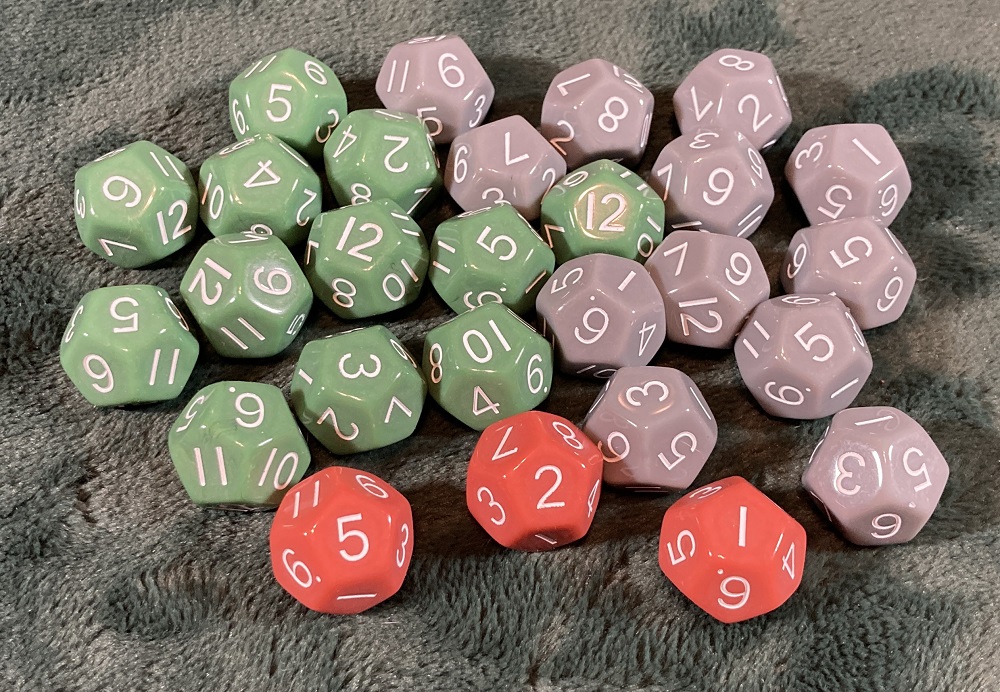
There are 12 black dice and 12 green dice which are used by the two teams. There are also three additional red dice which are used by the attacker for attack bonuses.
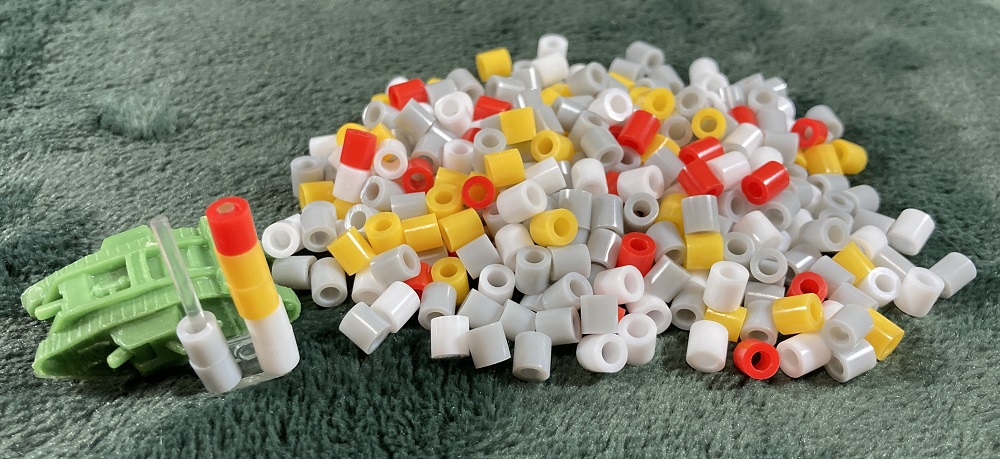
The included bag of beads are used to represent damage inflicted on a unit as well as its experience. Gray beads are used for damage and white, yellow, and red are used for experience.
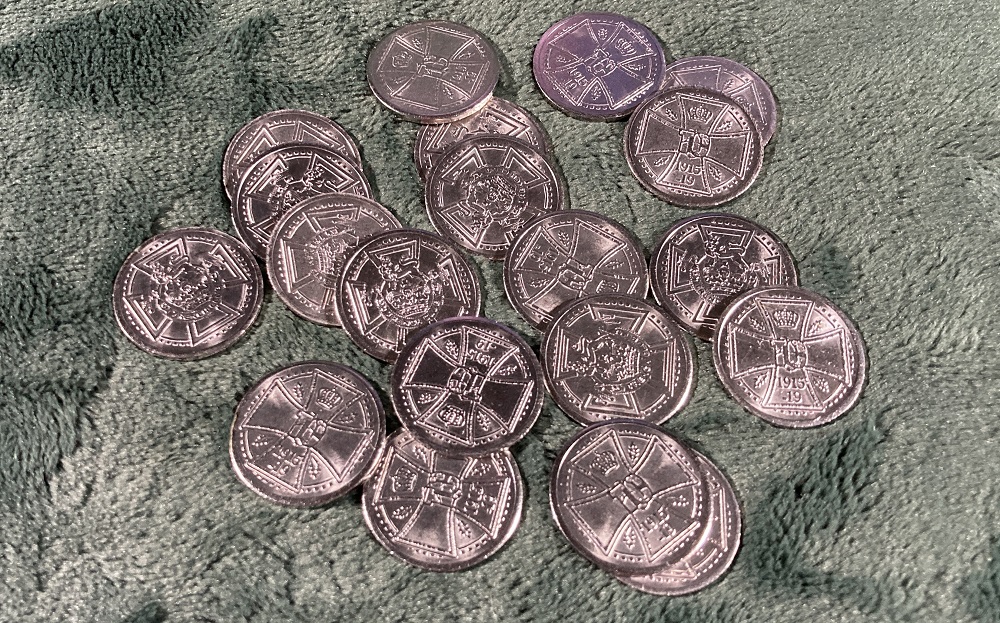
The metal coins are the currency of the game. Players earn them for owning forts and can spend them to repair damaged units or purchase additional units.

Some of the game components are only used during the legacy game. These include the cards, the legacy board, the secret envelopes, and the boxes of miniatures. Keep these sealed until the game calls for players to open them.
How to Play Trench Club: Legacy
You can download a copy of the rulebook here. This section will cover how to play a skirmish game. Battles played in the legacy game may have different setups and special rules depending on battle. For example, at the start of the legacy campaign, players do not have access to tanks since they were not yet used that early in the war.
The Goal
The goal of the game is occupy 9 of the 14 forts on the map.
Setup
Players begin by forming teams and determining which factions they will play as (Germany and Austria-Hungary or France and Great Britain) and take their matching faction unit mat and their faction’s 11 miniatures. Place the gameboard in the middle of the play area. The 12 grey chip tokens are shuffled and three are distributed to each player. Players then divide their miniatures into armies armies around each of their three chip tokens. They can distribute their units as they choose and not every chip has to have units assigned to it. After all players have divided their units, they each roll a die. The first player is the one who rolls the highest number. They choose one of their three chips and flip it over. They then place their units at that numbered location on the map, starting with one unit on the numbered hex and the remainder adjacent to it. The next player to the left then places one of their armies on the map and this continues until all players have placed their units. Finally players each roll a dice again to see who goes first. The game is now ready to begin.
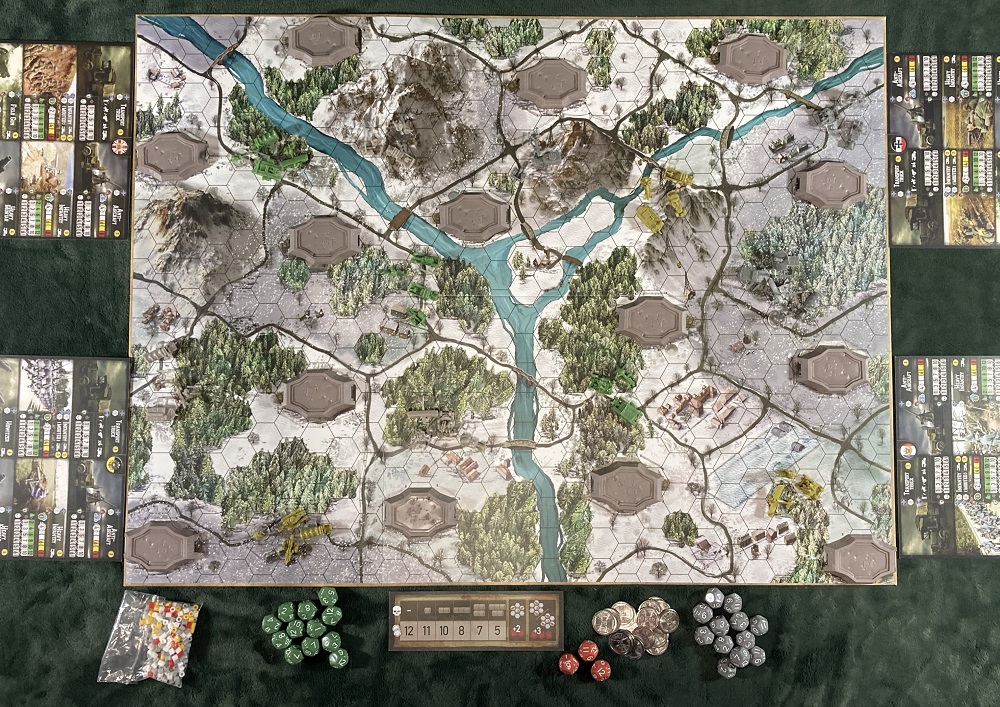
Gameplay
Trench Club: Legacy is played in turns with each player taking a turn followed by the player to the left. Each turn is divided into four phases: move troops, declare attacks, combat, and money transactions. Let’s take a look at each phase in more detail.
Move Troops
During this phase, the player can move any of their units they choose, one at a time. Each type of unit has a speed listed on the faction unit mats. That represents the number of speed points it can spend to move during a turn. Different types of terrain have different speed costs to enter. For example a meadow costs 1 speed point, a forest 1.5 points, and a road only 0.5 points. Players do not have to spend all of their speed points, but must complete the movement of one unit before they can move another. Moving adjacent to enemy units that can attack in close combat (at range 1) can affect movement. Also, units can move into a transport truck during their movement and then the truck can move its full speed and unload all transported units into adjacent hexes. Since trucks can carry up to four units, this is where planning the order of your movement is important. Moving to capture a fort is a bit different and is covered in its own section. However, you can move units into a fort that you own.
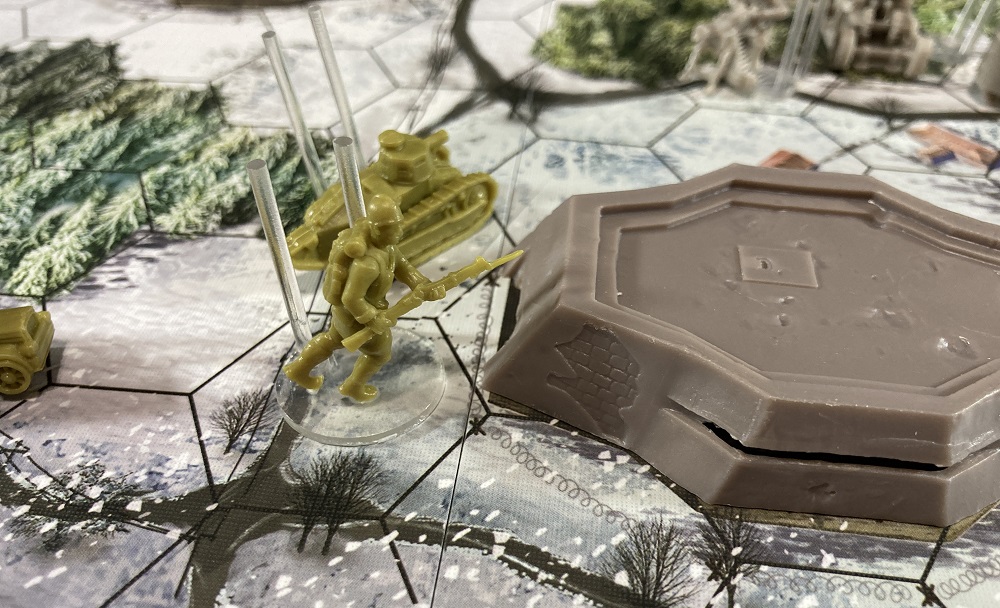
Declare Attacks
After a player has moved all of their units that they choose, they then declare attacks. First they must ensure that the target is in range. Most units can only attack at range one which is into an adjacent hex. Other units may attack at multiple ranges. Some also have a minimum range such as the field mortar which can’t attack adjacent units, only those at range 2-5. In addition to deciding which of your units will attack specific targets, you also must declare the order of the attacks. Once an attack is declared it can’t be changed later. For example, if you have two units attack the same enemy target and the first attack eliminates the target, the second unit cannot switch to attack another target. This is because all attacks are essentially taking place simultaneously.
Combat
After all attacks have been declared, the player then resolves those attacks in the order declared. Each attack is conducted in 8 steps. First the attack is announced. Then determine whether the defender can shoot back. This only occurs if the attack is close combat (at range 1) and the defender can attack in close combat. Third, the attacker (and defender if they can shoot back) determine the number of dice they can roll by using the dice chart. Undamaged units roll 12 dice and the more damage a unit takes, the fewer dice they roll. Fourth, check to see if the attacker get a bonus for either a flank attack (another of your units is adjacent to the target, but does not have to attack) or a surround attack (there are friendly units adjacent to the target and directly opposite from the attacker). In those cases, the attacker gets to roll either 2 or 3 bonus red dice respectively.
Fifth, the players who can attack or shoot back roll their dice and determine the number of hits they score. Locate this number on the unit mat. Rookie units use the number in the white space, veteran units the number in the yellow space, and war heroes use the number in the red. This hit number represents the number or less which must be rolled to get a hit. So if a unit rolls 12 dice and has a hit value of 3, count up all of the dice rolled with a 1, 2, or 3 on its face. Sixth, players determine the amount of damage a unit receives. Look at the damage tables of the unit that was hit on the unit mat. Some units have two hit rows. The one with a tree is used if the unit is in a forest hex. Otherwise use the other row. Find the number of hits or less and then look at the number in the damage row at the bottom. That shows how much damage that unit takes. Seventh, take one gray bead for each damage received and place it on the damage tracker on the unit’s miniature. If a unit ever has six or more damage, it is eliminated. Finally, if a unit inflicted damage on another unit, it receives an experience point. If the enemy was destroyed, two experience points are awarded. The color depends on the experience of the unit. Units get beads in this order, two white (XP 1 and 2), then two yellow (XP 3 and 4), and then finally one red (XP 5). The higher a unit’s experience, the more likely it will inflict more hits.
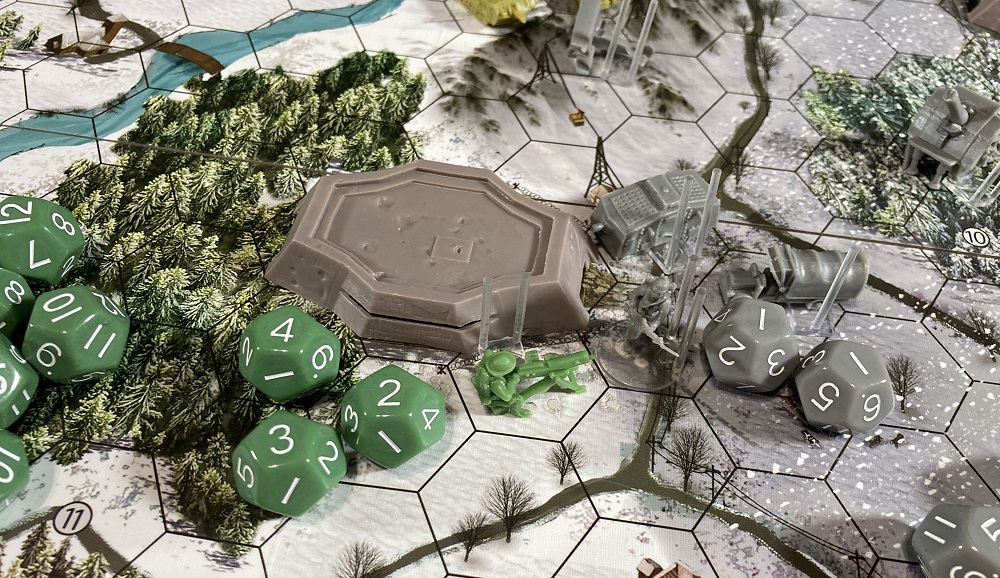
Money Transactions
During this phase, a player collects 1 coin for each fort they occupy. They can then use their coins to repair or purchase new units. To repair a unit, that unit must have been in the fort at the start of the turn (moved into it on a prior turn). It costs 2 coins to repair a unit and all damage is removed. It can then leave the fort on the following turn. To purchase a new unit, pay the cost listed on the unit mat. New units can be placed inside any of the player’s own forts.
Capturing Forts
Owning forts not only helps you get closer to victory, each fort also provides income each turn. In order to capture a neutral or enemy fort, a player must move one of their infantry units onto a hex adjacent to one of the fort’s two entrance. Then the following turn, it can enter and conquer the fort during the move troops phase. This means that it essentially takes two turns to capture a fort. Move adjacent to the entrance on the first turn, and then conquer the fort on the second. Any enemy units inside the fort are eliminated. The conquering player then places a flag token of their faction on top of the fort to show they now own it. It is important to note that the units in the fort do not get to shoot back because their is no combat in the normal sense. Therefore, if an enemy infantry unit moves adjacent to one of your fort’s entrances, either eliminate that enemy or get all of your units out on your turn before they conquer it. Note that units in a fort cannot attack. They must first move out of the fort in order to attack.
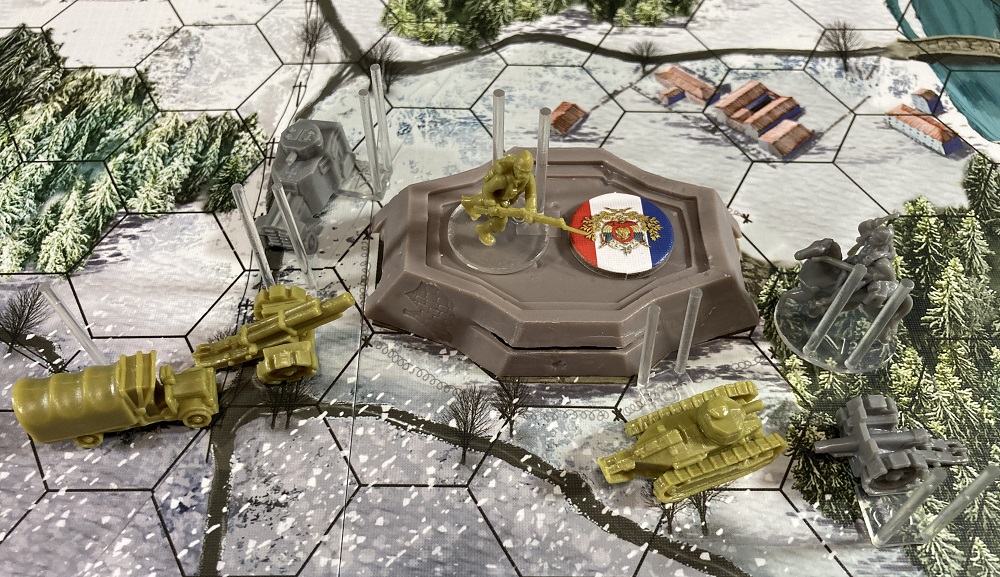
Game End
The game ends immediately when one team wins by being the first to occupy 9 forts or the other team surrenders. For shorter games, players could set the victory condition at 7 forts at the start of the game.
Playing the Legacy Game
The legacy game involves players taking part in a campaign of linked battles. While the individual battles play very similar to the skirmish game, the legacy game adds additional elements. At the start of the campaign, players take the deck of legacy cards and read card 0 which then tells them which cards to use for that battle. They will usually include an instruction card, briefing cards, rules cards which can add new rules to the game, and event cards. There are also news cards, which have letters rather than numbers, that help tell the story of the campaign. The legacy board uses strikers to keep track of each sides progress in the war. As players progress through the campaign, they gain access to new units and even officers. Once the campaign is completed, then players can use all of the unlocked units and rules to play individual scenarios.
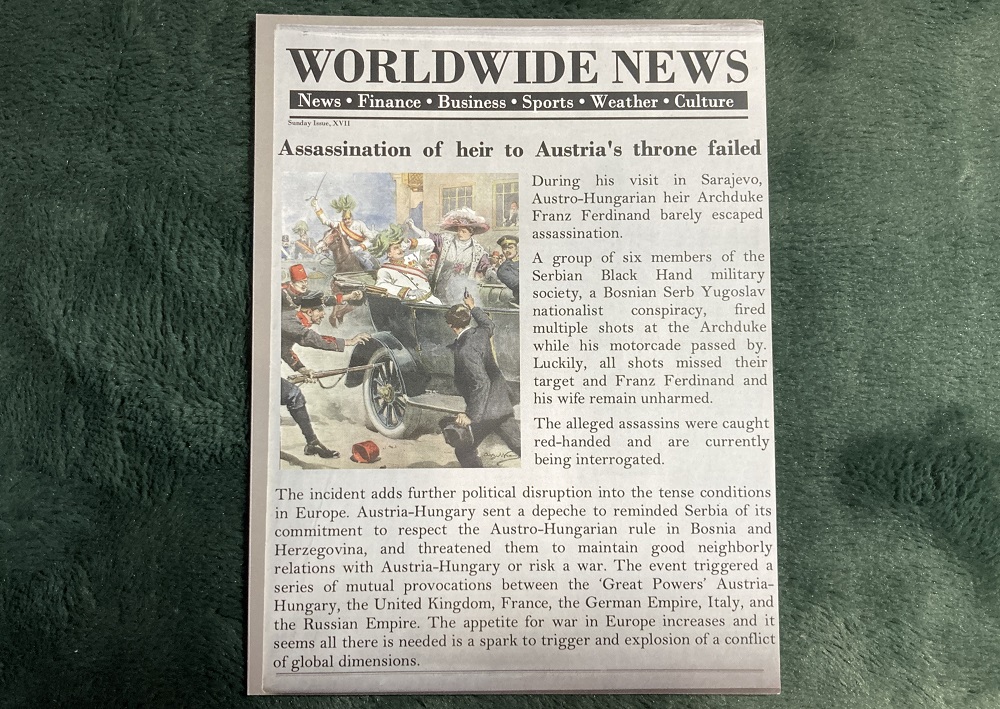
Why You Should Play Trench Club: Legacy
As a high school history teacher who majored in history with an emphasis on military history, I enjoy playing tabletop games with a historical theme, especially a military theme. There are a lot of games out there covering World War II but not as many covering the First World War. One of the reasons was most people think only of the trenches and futile charges across No Man’s Land. While that was a large part of the war, there was much more to it. Trench Club: Legacy takes the skirmish battle game of Trench Club, which is fun by itself and adds a legacy layer which helps tell an alternative story of the Great War that the players guide as they play through the campaign. In other words, it takes a good game and makes it even better.
Unlike the stalemate of the Western Front with static lines of trenches, Trench Club: Legacy offers players a lot of strategy in the way their maneuver their units. Since battles start with player’s units divided into armies and scattered randomly around the map, each battle offers a new challenge. There are no front lines, though players may try to create lines by moving their units to form a line. While you want to destroy enemy units, the real objective is to conquer and control the forts. The way forts work is actually quite interesting and is designed to represent the forts of the actual war. Most forts were too strongly built to destroy by artillery, so it was usually done by infantry assaults on the entrances. In fact, they could be vulnerable is the enemy could get in close. Therefore, while units inside forts cannot be attacked directly, they are destroyed if the fort is captured and an enemy. Plus there are no dice rolls to capture a fort. All you need to do is keep an infantry unit adjacent to an entrance and if it survived all the other players turns, you conquer the fort. I also like the way unit stats are kept. The use of beads to represent damage and experience is unique and works great. Units can take quite a bit of damage before they are destroyed, but each damage reduces the amount of dice they roll when they attack. As for experience, the more they gain, they more effective they are at damaging enemies. Therefore, you want to avoid having your units destroyed so they can take advantage of their experience. Since units gain experience by damaging or destroying enemy units, a good tactic is to have every unit attack enemies each turn so you can build up experience. Just be careful since if you are attacking in close combat, your opponent may get to shoot back and not only damage your units, but also gain experience.

While I enjoy the gameplay of the battles, the legacy campaign really adds to the experience. Each battle of the campaign begins with a news article describing the situation, instructions for setting up the game, briefings for each side, new rules that apply to that battle, and then an event that can be triggered during the battle. At the start of the campaign, each faction has only infantry, artillery, and transport trucks. There are no aircraft or tanks yet. Over the course of the campaign, each faction specialize in a different type of technology and receive special units of that category as the campaign progresses. As they win battles, they also conquer territory on the legacy board. While each faction has almost the same types of units, with the exception of their faction’s unique unit, the specialized units can really help players who take advantage of their unique abilities. I don’t want to give anything away, but these special units are some of the iconic weapons developed during this war. If that were not enough, players eventually gain access to officers which they can customize with different abilities and even the battlefield maps can change as players add stickers and other features just like the battles of the war changed the landscape of the Western Front. Once you have completed the campaign, you can use the new units in skirmishes or rest the campaign. The legacy board has two sides so you can just flip it over and start a new campaign. While you do put stickers on maps and cards, you do not destroy any of the components during the campaign.
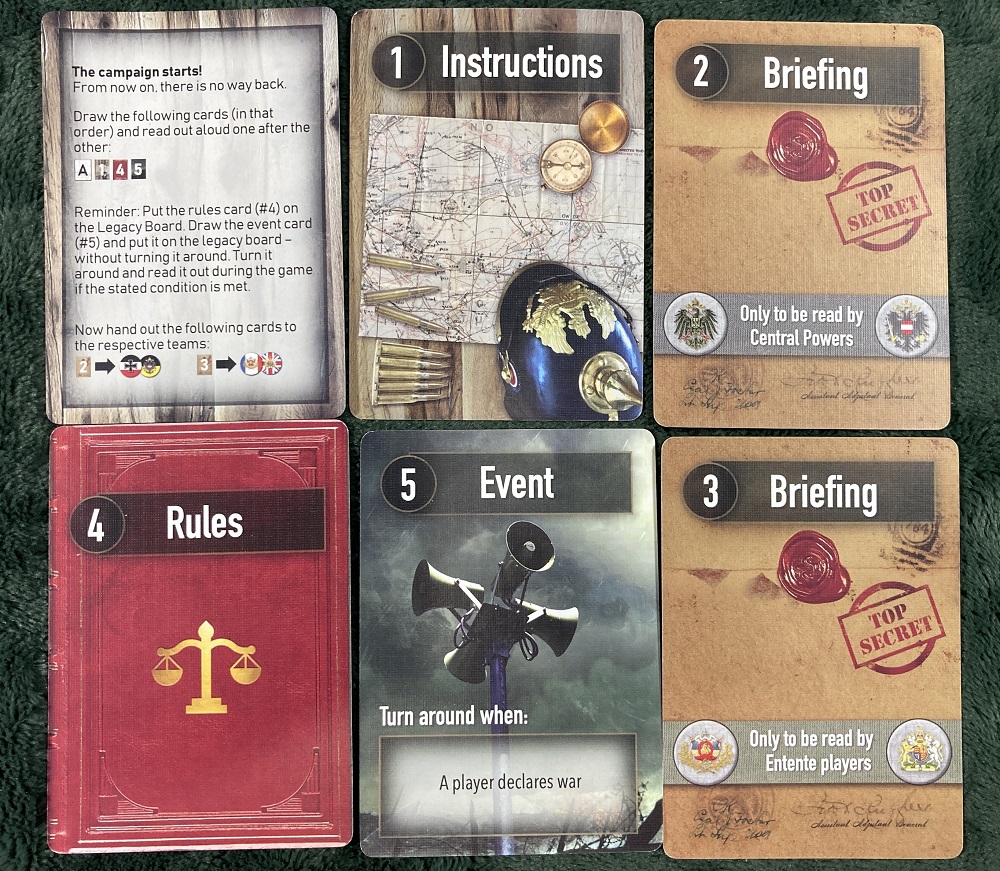
Though I have not completed the entire campaign yet, I am really enjoying playing Trench Club: Legacy. It is somewhat different from other war games, but that difference is what makes it a fresh game that does not just follow the standard format. Plus being able to play through the war with a legacy campaign provides not only a story, but also a reason to win each battle since this will benefit you during the campaign. Trench Club: Legacy can be played with just two players. In skirmishes, you only use half of the map and half the number of forts. There are also solo rules for both skirmishes and the campaign with directions to control the enemies. I recommend Trench Club: Legacy for those looking for a different type of wargame that will keep you coming back to the table. If you are debating whether to get Trench Club or Trench Club: Legacy, definitely go for Trench Club: Legacy. The legacy campaign is definitely worth it, adding not only a campaign, but also lots of new units you can then use in battles once the campaign is completed.
For more information, visit the Trench Club: Legacy webpage!
Click here to see all our tabletop game reviews.
![]() To subscribe to GeekDad’s tabletop gaming coverage, please copy this link and add it to your RSS reader.
To subscribe to GeekDad’s tabletop gaming coverage, please copy this link and add it to your RSS reader.
Disclosure: GeekDad received a copy of this game for review purposes.



